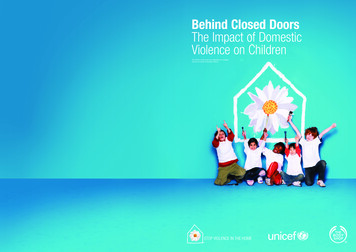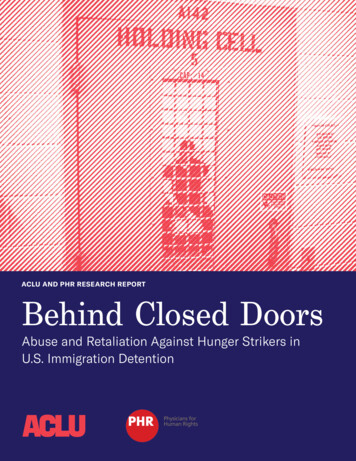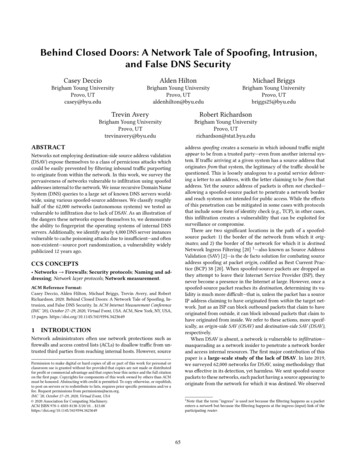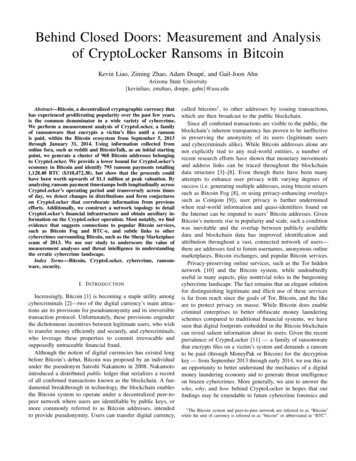
Transcription
BEHIND CLOSED DOORSA STUDY ON SWEDISH AUTHORITIES PERCEPTIONS ON GENDER OF OFFENDERSAND VICTIMS OF INTIMATE PARTNERVIOLENCEMARIA PUURDegree Project in Criminology46–60 creditsOne-year masters ProgrammeMay 2019Malmö UniversityHealth and society205 06 Malmö
BEHIND CLOSED DOORSA STUDY ON SWEDISH AUTHORITIES PERCEPTIONS ON GENDER OF OFFENDERSAND VICTIMS OF INTIMATE PARTNERVIOLENCEMARIA PUURPuur M. Behind Closed Doors. A Study on Swedish Authorities’ Perceptions onGender of Offenders and Victims of Intimate Partner Violence. Degree project incriminology 15 credits. Malmö University: Faculty of Health and Society,Department of criminology, 2019.Intimate partner violence is a global issue that occur in both opposite and same-sexrelationships, with both male and female offenders, but also with male and femalevictims. The police and social services are the two main authorities in Sweden toevaluate the situation of intimate partner violence, identify the offender, examinethe probability of future violence, and to provide victim support. The purpose ofthis paper is to investigate Swedish authorities' perceptions regarding intimatepartner violence from a gender perspective, using an experimental vignettetechnique. The study examines the perception of stereotypical and non-stereotypedgender and gender roles through various constructs and aims to explore howoffenders and victims of intimate partner violence is perceived by police employeesand social workers. The participants age, gender, education background, and workexperience of intimate partner violence is also analysed in combination withvariances of perception regarding offender and victim culpability, offender risk andthe severity of the incident. The result of the study follows previous literature wheremale-to-female intimate partner violence is perceived as more severe, and maleoffenders as more culpable, though the differences are minor. Further does thisstudy indicate only small differences between perceptions of gender between policeemployees and social workers.Keywords: gender differences, IPV, offender, perceptions, police, same-sexrelationships, social worker, victim2
ACKNOWLEDGEMENTSI would like to begin by thanking Viveka at the section for domestic violence withthe Police in Malmö for the opportunity to write this thesis. I would also like tothank all the participants, both police employees and social workers, for your timeand all the important work that you do every day.I want to express a special gratitude to my supervisor, Klara Svalin, for yourwonderful commitment and support that has empowered me to carry out all thework with this paper.But above all I want to thank my beautiful family for being there always.3
CONTENTINTRODUCTION5Aim and research questions6BACKGROUND6Offending and victimisation6Perceptions of intimate partner violence8Problematic and conservative attitudes towards intimate partner violence8Perceptions of offenders and victims8Police al easures14Variables14RESULTS15Swedish authorities’ perceptions15Perceptions of offenders and victimsParticipants characteristics and their perceptionsDISCUSSION151718Result discussion18Methodology discussion and study limitations18Conclusions20REFERENCES21Appendix I23Appendix II24Example 124Example 224Appendix III25Appendix IV26Appendix V27Appendix VI28Appendix VII294
INTRODUCTIONViolence comes in many different forms and variations, it differs between variouscontexts and depends on who exercises it and against whom, when it is exercisedand how and why (Nilsson & Lövkrona, 2015). Most violence is considered acriminal act, but vary between time periods, society and cultures (ibid). Violenceexists within different dimensions and the concept is multifaceted and ofteninvolves a thin line between what is public and private and between what islegitimate and illegitimate (Ray, 2018).Violence within intimate relationships is a global social issue that every day affectmany women, men and children all over the world. A meta-analysis, containingdata from 81 countries, shows an average global lifetime prevalence of intimatepartner violence (IPV) against women at 30 percent (Devries et al, 2013). Theprevalence varies within the globe and the occurrence for western Europe, includingSweden, is lower, at 19.3 percent (ibid). Though, giving the National Council forCrime Prevention in Sweden (NCCP), the lifetime victimisation of IPV, is 25.5percent for women and 16.8 percent for men aged 16-79 years old (NCCP, 2014).According the last made report of intimate partner violence in Sweden, almost asmany males, 6.7 percent, as females, 7.0 percent, reported being victimized duringone year (NCCP, 2014), and this is similar to other countries as well (Russell, 2018).Some minor studies show that IPV also occur within LGBT1-relationships (NCCP,2017, Russell, 2018), and that it is a growing problem (Baker et al, 2013).Self-reported victimisation seems to be stable over time and police reports of IPVappears to be increasing, still, the dark number of victimizations is still thought toremain high (NCCP, 2014). The high dark number may be a consequence due tothe fact that IPV is a crime type that is less visible since it has a tendency to occurin a private context or setting (de Vogel & Nicholls, 2016). Self-reportedvictimisation shows that the number of women reporting IPV to the authorities is4.9 percent, while the equivalent share of men is only 2.9 percent (NCCP, 2014).Studies on women’s victimisation of IPV has revealed reasons for not reporting anincident to be because of an wish to quiet down what has happened and to keep itprivate, or because they want to protect the offender (ibid). Other reasons may bethat they are afraid of the consequences of an police report being filed, butcommonly also that they wait with reporting to the police, hoping that the situationwill get better (ibid).IPV is a broad term since the crimes can be quite diverse (Fisher et al, 2016), andtherefore it can take many different forms, including physical assault, rape andsexual violence, psychological or emotional violence, but also torture, financialabuse, and control of movement and social contacts (Ray, 2018). Even though theterm is so varied, each victimization entails deliberate harm that are being inflictedon the victim by a current or former intimate partner (Fisher et al, 2016). Severalstudies reveal that it is less common to report crimes where the offender is knownor related to the victim, compared to when the offender is unknown (ibid).Research on IPV tend to mainly focus on male-to-female IPV that occurs inopposite-sex relationships, even though there are studies which has showed that isnot always the case (NCCP, 2014). Contemporary research has started to broaden1An initialism that stands for lesbian, gay, bisexual, and transgender.5
its perspective and studies on female-to-male IPV are today being conducted to agreater degree to extend our knowledge (Storey & Strand, 2013). Still, there islimited knowledge on female-to-male IPV and IPV that occurs within LGBTrelationships (NCCP, 2017). This can lead to limitations regarding how the justicesystem and other authorities in society are managing and preventing IPV, since themethods usually are based on male-to-female violence (ibid). The Swedish NationalCouncil for Crime Prevention, therefore, highlights the importance of future studiesregarding gender differences within IPV and the importance of the justice systemand other authorities, to review their own beliefs about who it is that offend, andwho it is that becomes victimized by IPV (ibid). Society and its representatives tendto perceive some victims of IPV as more worthy than others (Sorenson & Thomas,2009), and therefore it is important that police employees and social workers, whohas a mission to see to, prevent and react against IPV, are aware of their own viewsregarding victims and offenders and the potential effect that these views can havein their work with IPV. Hence their perceptions are important in the work with bothrisk assessment and victim support.Aim and research questionsThe purpose of this study is to investigate the Swedish authorities' perceptions aboutintimate partner violence from a gender perspective. This because perceptions andjudgments about offenders and victims of IPV often are based on individuals'collective professional knowledge and belief, but also on the basis of personalvalues that vary between different individuals and their view of society. The workaims to examine whether there are differences regarding perceptions of offendersand victims of crime, between different groups that come into contact with IPV;this based on the participant's workplace, education background, years of workingwith IPV, age and gender. The study will investigate the perception of stereotypicaland non-stereotyped gender and gender roles through various constructs that arerelevant towards work with victims and offenders of intimate partner violence. Toanswer the aim, this study is conducted based on two research questions:Q1Q2How does Swedish authorities, police employees and social workers,perceive offenders and victims of intimate partner violence in bothopposite and same-sex relationships?Can variances in perceiving’s be related to participantscharacteristics, such as gender, age, education background or workexperience with intimate partner violence?BACKGROUNDIntimate partner violence is a complex phenomenon, no matter what type ofrelationship it occurs in or who it is that offend or becomes victimized. Theupcoming part of the paper will show just how complex IPV can be according toprevious research, how it has been viewed back in the days, and how IPV betweenmen and women are perceived in other studies.Offending and victimisationThe victimisation of IPV has various patterns depending on who it is that becomesvictimized and who it is that carries out the violence (Ray, 2018). The most commoncouple-related violence, which both women and men perform, is usually marked by6
temporary anger and aggression (Ray, 2018; Scarduzio et al, 2017), and both menand women engage in similar patterns of situational and reactive violence (Espinoza& Warner, 2016). Situational couple violence is described as a conflict based on theresult of an occasional argument which has escalated (Scarduzio et al, 2017).Research has revealed that within opposite-sex relationships, women and men arelikewise as aggressive and controlling and the behaviour and aggression is oftenbidirectional (Bates et al, 2018) and when the aggression is bidirectional, partnersare less likely to see themselves in the need of help (Espinoza & Warner, 2016).Another type of violence, which is most often committed by men, is morecompulsive and is characterized by serious escalation of violence and terrorism(Ray, 2018; Scarduzio et al, 2017). Intimate terrorism is described as the systematicuse of not only violence, but also the use of other controlling tactics, for exampleeconomic subordination, threats, and isolation in order to secure constant andnonstop power over a spouse (Scarduzio et al, 2017). Some researchers claim thatmen are more likely to offend than women, while other researchers argue thatwomen are more frequently violent toward men and engage in more coercive andcontrolling behaviours (ibid). Another pattern of IPV is that it is more likely toinvolve repeat victimization and more probable to result in physical injury than anyother type of crime directed towards a person (Ray, 2018). As prior violence andvictimization is a strong risk factor for future violence, IPV is typically seenescalating and approximately one third of the upcoming episodes of violence occurwithin five weeks of the first (ibid). This is disturbing since about forty percent ofwomen and almost 67 percent of men, stated that the main reason for not reportingIPV to the police is because they consider the incident to be a small thing (NCCP,2014).The aim for control is an equal underlying motivator for both male and female IPV,even though female offenders are more likely than males to use a weapon and domore commonly explain their use of violence with lost temper, jealousy, desire forcontrol or to punish the partner, retaliation or self-defence (Espinoza & Warner,2016). Despite that some evidence indicates that only a small quantity of offendingfemales use violence as an act in self-defence, most of both the past and the presentdiscourse, refer to women’s use of violence in opposite-sex relationships as a primeresponse to victimisation by males (ibid). Research on both male and femaleoffenders show a symmetry of psychological features that include jealousy, anxiousand insecure attachment, controlling behaviours, impulsivity and antisocialbehaviour including lack of self-control (ibid).IPV is, whoever offends or becomes victimised, obviously a complex crime typeand international research reveals that both men and women experience IPV atsignificant rates (Baker et al, 2013). Several studies have shown that menexperiencing IPV has difficulties in identifying themselves as victims and beingrecognized by others as victims (ibid). Research has revealed that men are moreunwilling to report assaults and to seek medical care, which might be a function ofthe societal perception of masculine gender roles (Bates et al, 2018). Female victimsare four times more likely to report, which might be due to that female-perpetratedabuse is less likely to be viewed, by both male victims and many other individualsin the population, as a crime (Espinoza & Warner, 2016). Some men that seek helphave been met with scarce resources and rejection from aid programs and beengiven negative experiences (ibid). Male victims revealed that female perpetrationof IPV sometimes has been viewed as a joke and some males has even been arrested7
and or removed from the home without adequate evidence of male violence(Espinoza & Warner, 2016).Perceptions of intimate partner violenceFor centuries, IPV, has not been considered a serious problem (Ray, 2018). It wasnot until the 80s that the police in the US and the UK started to more seriouslypursue the problem of IPV and this was done in response to feminist campaigning(ibid). Prior the 80s IPV was viewed as a private matter that did not need theattention of police or other authorities (McPhedran et al, 2017).Problematic and conservative attitudes towards intimate partner violenceThe issue of violence within intimate relationships was back in the days morereferred to as wife abuse and was mostly based on a patriarchal and heteronormative marriage model (Baker et al, 2013). A patriarchal ideology views thepractise of power and violence as an acceptable way to resolve disagreements andsees men as authorised to control women in their intimate sphere (ibid). Thepatriarchal system legitimizes the control of women and the use of force as a meansto keep that control, which in turn puts violence against women less likely to beviewed as deviant or criminal; particularly when it happens within the context of anintimate relationship (Ray, 2018). In a patriarchal system there is only a heteronormative frame and same-sex relationships is either invisible or deviant (Baker etal, 2013). In order to understand, what use to be seen as asymmetry of who getsvictimized of IPV (i.e. more females than males), research has largely focused onthe historically and socially created influence of patriarchy in accepting men tocontrol and dominate their female partners (Bates et al, 2018).There are both problematic views of IPV and some more liberal views, though thereis only little research on positive attitudes regarding IPV because most studies,especially when it comes to police perceptions, focus on officers’ negative orstereotypical views (DeJong et al, 2008). With that in mind, international researchhas during the last decades showed that there are a variety of reasons why policeofficers might dislike or resist to respond to IPV calls (ibid). Some reasons are dueto that it sometimes can be hard to see who is the victim and who is the offender,because there are not always any signs that an criminal act has even occurred (ibid).Other reasons are that some individuals, with limited knowledge, fail to appreciatethe complex nature of IPV, for example regarding the numerous reasons whyvictims stay with their abusive partners (ibid). As said above, there are also reasonsin form of patriarchal, misogynistic or sexist opinions which may blame women fortheir own victimisation (ibid). Contrary to the sociocultural prescribed patriarchyas one of the most important reasons for IPV, the majority of males endorserespectful opinions towards women and are less accepting of men using retaliatoryviolence in responding to women’s practice of violence (Espinoza & Warner,2016).Perceptions of offenders and victimsEven though evidence points towards gender symmetry of IPV, female-to-male IPVis often viewed as less common and less problematic - and even less consequentialthan male-to-female IPV (Espinoza & Warner, 2016). Both men and women areseen to perceive female offenders as less blameworthy and are less probable to handout responsibility to female offenders compared to male offenders (ibid). Male-tofemale IPV is also expected to be perceived in favour for reporting to theauthorities, which leads to consequences where witnesses might be less likely to8
intervene or to alert authorities in cases with female-to-male IPV (Espinoza &Warner, 2016). Research that employs hypothetical gendered IPV scenarios hasrevealed that individuals view acts of violence as less serious in cases where thevictim is male and the offender is female and female violence is more likely to beperceived as dependent on the context, compared to male violence, which mightmake some people look for external and broader explanations for that kind ofbehaviour from women (Bates et al, 2018).Even if bidirectional IPV is a common form, female violence is still viewed in amore acceptable way and is usually more often explained by a lot of other factors,compared to male violence (Espinoza & Warner, 2016). Violence exercised by menhas a tendency to receive greater blame for comparable acts (Espinoza & Warner,2016), which might be in regard of gender-role stereotypes that incline perceptionsof males as stronger and more likely to offend and women more vulnerable andprobable to be victimised (Ahmed et al, 2013). In a vignette study, by Ahmed andcolleagues (2013), scenarios where the offender is male were considered as moreserious than scenarios where the offender were female. Also, scenarios where thevictim was a female was perceived as more serious than when the victim was a male(ibid). The victimisation of males can in itself be viewed as an aberration frommasculine gender roles and might therefore be met with attitudes of both confusionand blame toward male victims and these victims obtain greater negativestigmatisation than female victims (Espinoza & Warner, 2016). Internationalresearch shows a bias against male victims and more of an lenience toward femaleoffenders and studies have revealed that men are more likely than females to bearrested, charged and convicted (Espinoza & Warner, 2016). This alongside thatmen’s statements of self-defence are much less likely than women’s to be believedby the justice system (ibid). In IPV cases where there is no injury, men are morelikely to be charged and cases involving male injury, women were arrested at justabove 60 percent, compared to over 90 percent of males arrested in IPV casesinvolving female injury (ibid).There is substantial literature regarding public attitudes and perceptions of IPV inopposite-sex relationships, but research on perceptions of IPV within same-sexrelationships is still quite limited (Ahmed et al, 2013). The public opinion regardingsame-sex attraction in Sweden are one of the most liberal and accepting in Europe,alongside the Netherlands and Denmark (Gerhards, 2010). In Sweden, LGBTindividuals can live their lives quite openly and the law endorses the same privilegesand opportunities as others (Ahmed et al, 2013). Even so, male-to-female IPV havebeen viewed as more serious than any other gender constellation, both in the lessand more severe scenarios in a Swedish vignette study (Ahmed et al, 2013). This isin line with the prediction made on the basis of gender-role stereotypes - that IPVthat involves both a male offender and a female victim is perceived as the mostserious incident, regardless of the severity of the violence (Ahmed et al, 2013).Further, female participants were also seen to show greater levels of concern thanmale participants regardless of gender and gender orientation of offender or victim(ibid).Police perceptionsPolice officers are the main authority to evaluate, both the evidence and the situationof IPV, identify the offender, examine the probability of future violence, andprovide victim support (Russell, 2018). In order to respond to an IPV incident,police employees do several risk assessments regarding immediate and future risk9
of the threat of danger of physical harm (Russell, 2018). This assessment isinfluenced by their prior knowledge and beliefs regarding abuse and intimatepartner relationships (ibid). Previous research regarding police officers perceptionsis in line with public perceptions (Ahmed et al, 2013), as police employees findmale-to-female IPV as more serious and dangerous than female-to-male IPV or IPVin same-sex relationships (Russell, 2018). It is important that police officers are asopen minded as possible when it comes to violence risk assessment of IPV and byrelaying on prior knowledge and gender-based stereotypes, their decision-makingregarding culpability and risk can lead officers to over or underestimate a futurerisk or danger, which may leave the victims vulnerable to additional abuse (ibid).Women are perceived as less violent than men and the general perception is thatmen are less vulnerable, both to injury but also to the negative effects that oftenoccurs after being abused (Russell, 2018). Stereotypical perspectives may lead tomen being held more responsible for their own victimization and their truthfulnessas victim minimized (ibid). The postulation that offenders are masculine, andvictims are feminine may affect the perceptions of same-sex couples and researchhas showed that homosexual males are labelled as more womanly and less manlythan heterosexual males while homosexual women are perceived as more masculineand less feminine than heterosexual females (ibid). Both police employees andsocial workers have an important role to maintain in society and their perceptionsare therefore equally important. Though, literature regarding social service'sperceptions of IPV seems limited.METHODThis study has a quantitative approach with a factorial design. A quantitativeapproach is chosen because the data that is collected and analysed are quantitativeand because the current study is not in-depth going (King & Wincup, 2008). Thisdesign is used in order to examine group means within various populations and isalso called a factorial analysis of variance (Parke, 2010). Factorial designs often usescenarios or vignettes to describe a situation or event followed by some questions(Sorenson & Thomas, 2009). The design is also known as an experimental vignettewhen the levels of the factors are randomly assigned by the researcher (ibid). In thecurrent study, using a vignette technique, authorities perception will be measuredthrough an online survey and the design of the method are based on previousresearch by Russell (2018) and Ahmed and colleagues (2013), in order to make surethe method, that consist of vignettes regarding perceptions, is reliable. A vignetteaims to describe an event, happening, circumstance or other scenario and areflexible and can therefore be used to measure many different types of attitudes orbeliefs (Vargas, 2008). The technique is often used with closed questions in studiesregarding individuals’ norms and values (Bryman, 2008), and are particularlyuseful when aiming to measure complex constructs (Vargas, 2008). The techniqueis based on a few situations or scenarios that are presented to the respondents inorder to study their normative perceptions (Bryman, 2008).DataThe data used in this study were collected through an online survey using SunetSurvey. Each survey included three case scenarios or vignettes where the offenders’and victims’ gender were altered between each vignette constructing both opposite10
and same-sex couples. Participant recruitment was conducted in two parts, usingboth a convenience sampling (Battaglia, 2008) and a snowball sampling technique(Chromy, 2008) in order to access both police employees and employees in thesocial services. First, email has been sent to all seven police regions in Swedenasking for contact with group leaders within groups that works specifically withIPV or police officers working in external duty. Second, 64 municipalities in thesouth of Sweden has been contacted by email asking for contact with the socialservices in each municipality. Each established contact, both within the police forceand the social services, then got email invitations which described the aim andincluded a sign-up link to the study where the ones that are interested inparticipating could notify their interest. All contacts then were asked to forward thislink to their employees and co-workers.ProcedureOf the seven police regions and the 64 municipalities contacted, 41 policeemployees and social workers filled in the recruitment form on the sign-up link andwere interested in participating. The participants were gradually divided into sixgroups and were assigned different vignettes in order to increase the generalizabilityof the study. Group 1 and 5 were assigned the same vignettes and group 2 and 6other vignettes. The vignettes assigned to group 3 and 4 had the same content as thevignettes assigned the other groups, but with the difference that the gender of boththe offender and victim were manipulated and changed to other relationshipconstructs in order to further increase the generalisability between vignettes. Allquestionnaires were distributed gradually, while the recruitment progressed leadingto three rounds of questionnaire deliveries, first group 1 and 2, then group 3 and 4,and then group 5 and 6. The respondents were assigned two questionnairesrespectively, containing three scenarios each, that were handed out with about oneweek in between.In hope of increasing participation, as a thank-you message after eachquestionnaire, respondents has been encouraged to forward the interest sign-up linkto employees and colleagues. When the time for the study began to run scarce andthere no longer was any time to hand out two questionnaires to each respondent, thethank-you message was changed in the last two groups where the respondentsinstead were invited to hand out a link that led directly to a questionnaire containingfour vignettes that were the same as the vignettes for group 3 and 4. This raisedparticipation with four individuals, giving an improved sample of 45 participants.SampleWhen the publication time for the questionnaire expired, there were still twoparticipants who did not answer any of the two questionnaires, giving a final sampleof 43 participants, where one participant only answered the first questionnaire andnot the second. The final sample exists of 22 police employees (51.2 percent) and21 social workers (48.8 percent) and most participants, over 80 percent, are femaleand less than 20 percent are male. The participants age varies between 29 years to64 years old with a mean age of the total sample at 43 years. There is a higher meanage for police employees, 46 years compared to 40 years for social workers. In thesample there are 12 participants who have police training, 21 participants have readsociology or have an education as social worker, 5 participants have readcriminology and the rest has various kinds of degrees or no higher degree at all. Sixparticipants has a year or less experience of working with IPV and thirteenindividuals has 2 – 4 years of experience, eleven participants has 5 – 9 years’11
experience, while thirteen participants has ten or more years of experience ofworking with IPV.Ethical considerationsIt is important to make ethical reflections and considerations while conductingscientific research (Vetenskapsrådet, 2017). In order to ensure that research is donein an responsible manner, these reflections and considerations play an importantrole in the quality of research, implementation and in the results that are used todevelop our society (ibid). In research regarding individuals and sensitive data, suchas crime and victimisation, it is important that the researcher consider the potentialbenefits of the study to the possibility of harm to the participating individuals(Maxfield & Babbie, 2015). There are individuals that are more exposed to harmwhile participating in a study (ibid). Though, in the current study the participantsone way or another work with offenders and victims of IPV and should thereforenot be further harmed by this study. When conducting the current study, reflectionsregarding volunteerism, integrity, confidentiality and anonymity have constantlybeen made, from the planning of data and selection, investigation form,questionnaire and during the study and the ongoing work.The ethical principle regarding voluntary participation (Bryman; 2008; Maxfield &Babbie, 2015; Vetenskapsrådet 2017), were in this study satisfied by thatparticipants volunteered to participate and were informed that the purpose of thestudy was to study perceptions of IPV. All the group leaders that was
Puur M. Behind Closed Doors. A Study on Swedish Authorities' Perceptions on Gender of Offenders and Victims of Intimate Partner Violence. Degree project in criminology 15 credits. Malmö University: Faculty of Health and Society, Department of criminology, 2019. Intimate partner violence is a global issue that occur in both opposite and same .









